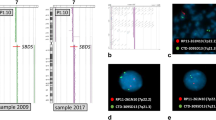Summary
In the lymphocytes of heterozygous carriers of the rare autosomal fragile site (16)(q22) an exceptionally high frequency of sister chromatid exchanges was demonstrated at the induced fragile site by means of simultaneous berenil and BrdU treatment of the cultures. The rate of sister chromatid exchanges at q22 is also increased in the fragile chromosome 16 by treating the cells with BrdU alone. The possible reasons for the preferential occurrence of induced and spontaneous sister chromatid exchanges at fra (16)(q22) are discussed.
Similar content being viewed by others
References
Bostock CJ, Christie S (1976) Analysis of the frequency of sister chromatid exchange in different regions of chromosomes of the kangaroo rat (Dipodomys ordii). Chromosoma 56:275–287
Carrano AV, Wolff S (1975) Distribution of sister chromatid exchanges in the cuchromatin and heterochromatin of the Indian muntjac. Chromosoma 53:361–369
Chernos JE, Rattner JB, Martin RH (1986) An investigation of human sperm pronuclear chromosome “gaps” using scanning electron microscopy. Cytogenet Cell Genet 42:57–61
Croci G (1983) BrdU-sensitive fragile site on long arm of chromosome 16. Am J Hum Genet 35:530–533
Crossen PE (1982) SCE in lymphocytes. In: Sandberg AA (ed) Progress and topics in cytogenetics, vol 2: Sister chromatid exchange. Liss, New York, pp 175–193
Crossen PE, Drets ME, Arrighi FE, Johnston DA (1977) Analysis of the frequency and distribution of sister chromatid exchanges in cultured human lymphocytes. Hum Genet 35:345–352
Dutrillaux B, Laurent C, Couturier J, Lejeune J (1973) Coloration par l'acridine orange des chromosomes préalablement traités par le 5-bromodèoxyuridine (BUDR). CR Acad Sci (D) 276:3179–3181
Dutrillaux B, Fosse AM, Prieur M, Lejeune J (1974) Analyses des échanges de chromatides dans les cellules somatiques humaines. Chromosoma 53:361–369
Festy B, Lallemant AM, Riou G, Brack C, Delain E (1970) Mécanisme d'action des diamidines trypanocides. Importance de la composition en bases dans l'association berenil-polynucléotides. CR Acad Sci (D) 271:684–687
Harrison CJ, Jack EM, Allen TD, Harris R (1983) The fragile X: a scanning electron microscope study. J Med Genet 20:280–285
Krey AK (1980) Non-intercalative binding to DNA. In: Hahn FE, Kersten W, Szybalski W (eds) Progress in molecular and subcellular biology, vol 7. Springer, Berlin Heidelberg New York, pp 43–87
Latt SA (1974) Localization of sister chromatid exchanges in human chromosomes. Science 185:74–76
Liu LF, Liu C-C, Alberts BA (1980) Type II DNA topoisomerases: enzymes which unknot a topologically knotted DNA molecule via a reversible double strand break. Cell 19:697–707
Painter RB (1980) A replication model for sister-chromatid exchange. Mutat Res 70:337–341
Painter RB (1982) A replication model for sister chromatid exchange. In: Sandberg AA (ed) Progress and topics in cytogenetics, vol 2: Sister chromatid exchange. Liss, New York, pp 115–121
Perry P, Wolff S (1974) New Giemsa method for the differential staining of sister chromatids. Nature 251:156–158
Sandberg AA (1982) Sister chromatid exchange in human states. In: Sandberg AA (ed) Progress and topics in cytogenetics, vol 2: Sister chromatid exchange. Liss, New York, pp 619–651
Sanfilippo S, Neri G, Tedeschi B, Carlo-Stella N, Triolo O, Serra A (1983) Chromosomal fragile sites: preliminary data of a population survey. Clin Genet 24:295
Schmid M, Klett C, Niederhofer A (1980) Demonstration of a heritable fragile site in human chromosome 16 with distamycin A. Cytogenet Cell Genet 28:87–94
Schmid M, Hungerford DA, Poppen A, Engel W (1984) The use of distamycin A in human lymphocyte cultures. Hum Genet 65:377–384
Schmid M, Feichtinger W, Jeßberger A, Köhler J, Lange R (1986) The fragile site (16)(q22). I. Induction by AT-specific DNA-ligands and population frequency. Hum Genet 74:67–73
Schwarzacher HG, Gropp A, Ruzicka F (1976) Fine structure of 33258 H-treated chromosomes. Hum Genet 33:259–262
Stetka DG (1982) Operative and non-operative mechanisms of sister chromatid exchange. In: Sandberg AA (ed) Progress and topics in cytogenetics, vol 2: Sister chromatid exchange. Liss, New York, pp 99–114
Sutherland GR, Jacky PB, Baker EG (1984) Heritable fragile sites on human chromsomes. XI. Factors affecting expression of fragile sites at 10q25, 16q22, and 17p12. Am J Hum Genet 36:110–122
Tucker JD, Christensen ML, Strout CL, Carrano AV (1986) Determination of the baseline sister chromatid exchange frequency in human and mouse peripheral lymphocytes using monoclonal antibodies and very low doses of bromodeoxyuridine. Cytogenet Cell Genet 43:38–42
Author information
Authors and Affiliations
Rights and permissions
About this article
Cite this article
Schmid, M., Feichtinger, W. & Haaf, T. The fragile site (16)(q22). Hum Genet 76, 365–368 (1987). https://doi.org/10.1007/BF00272446
Received:
Issue Date:
DOI: https://doi.org/10.1007/BF00272446




